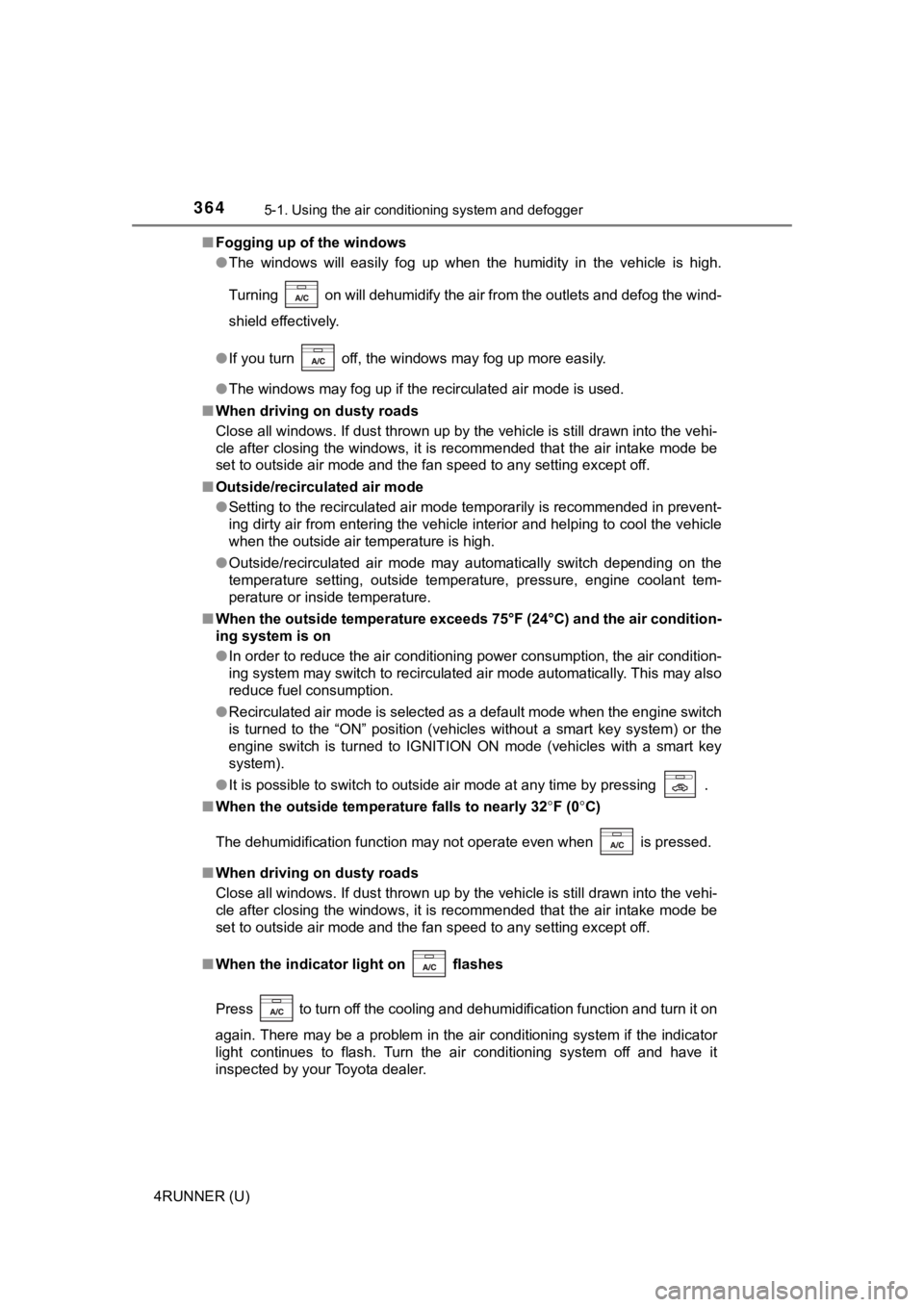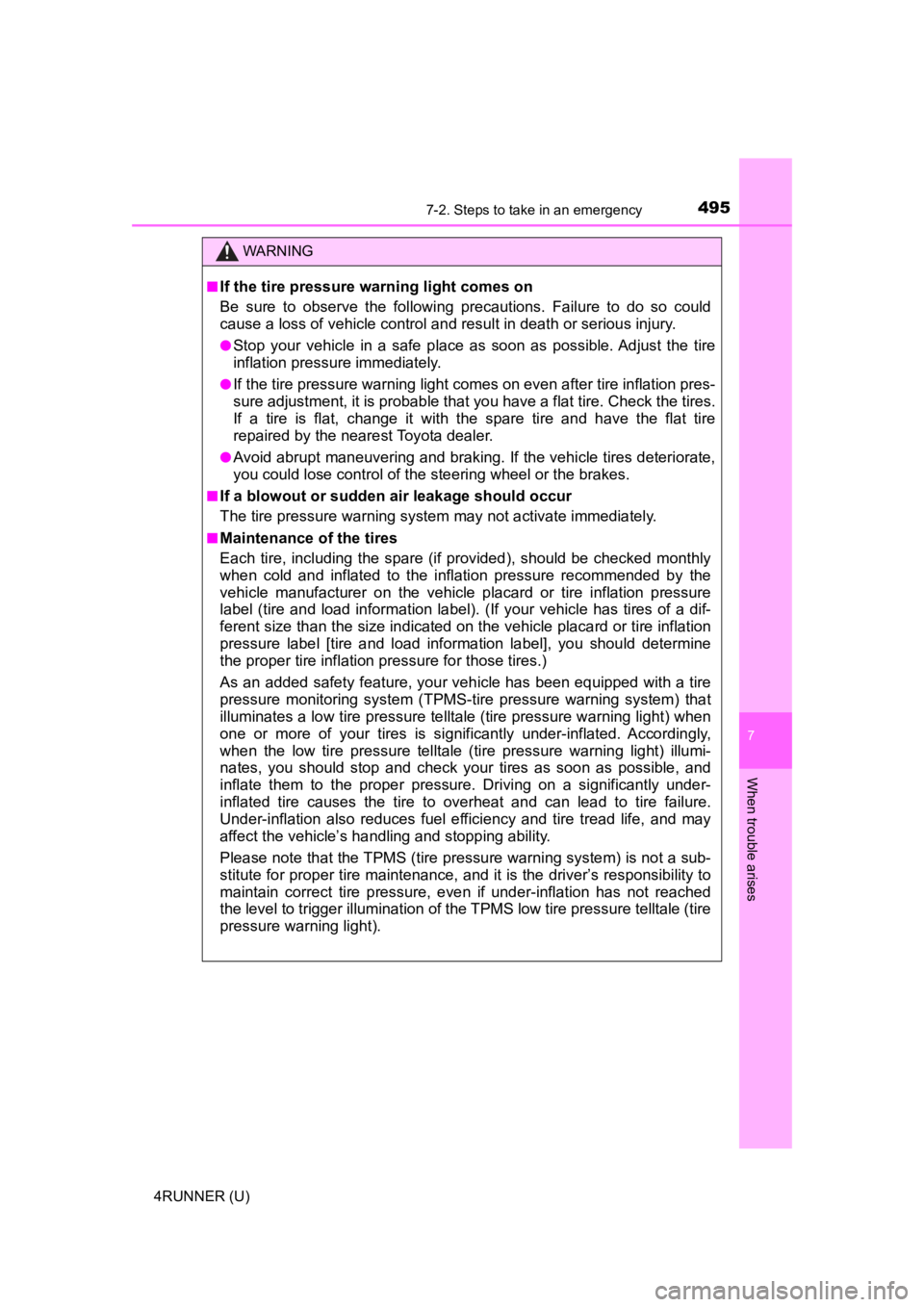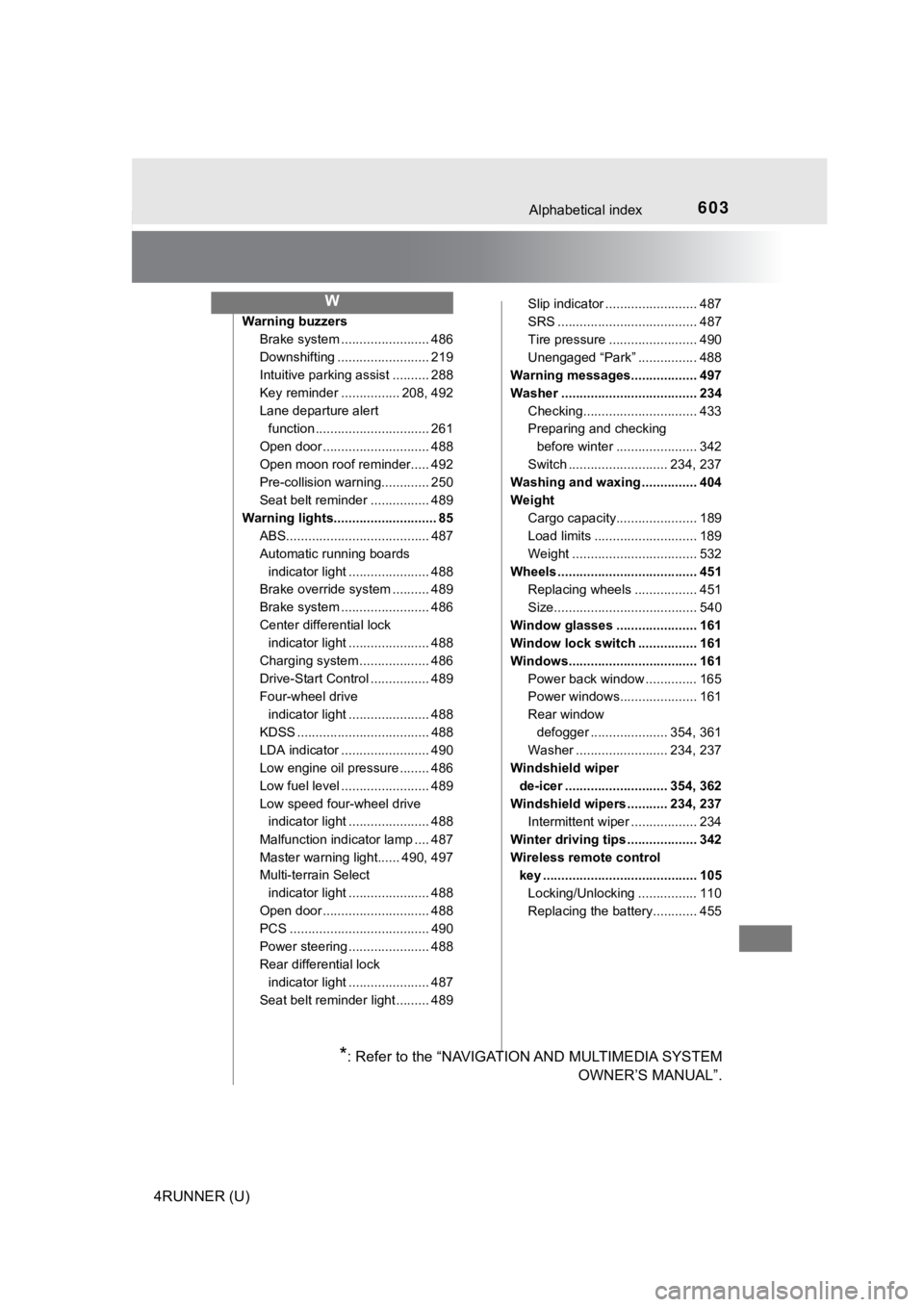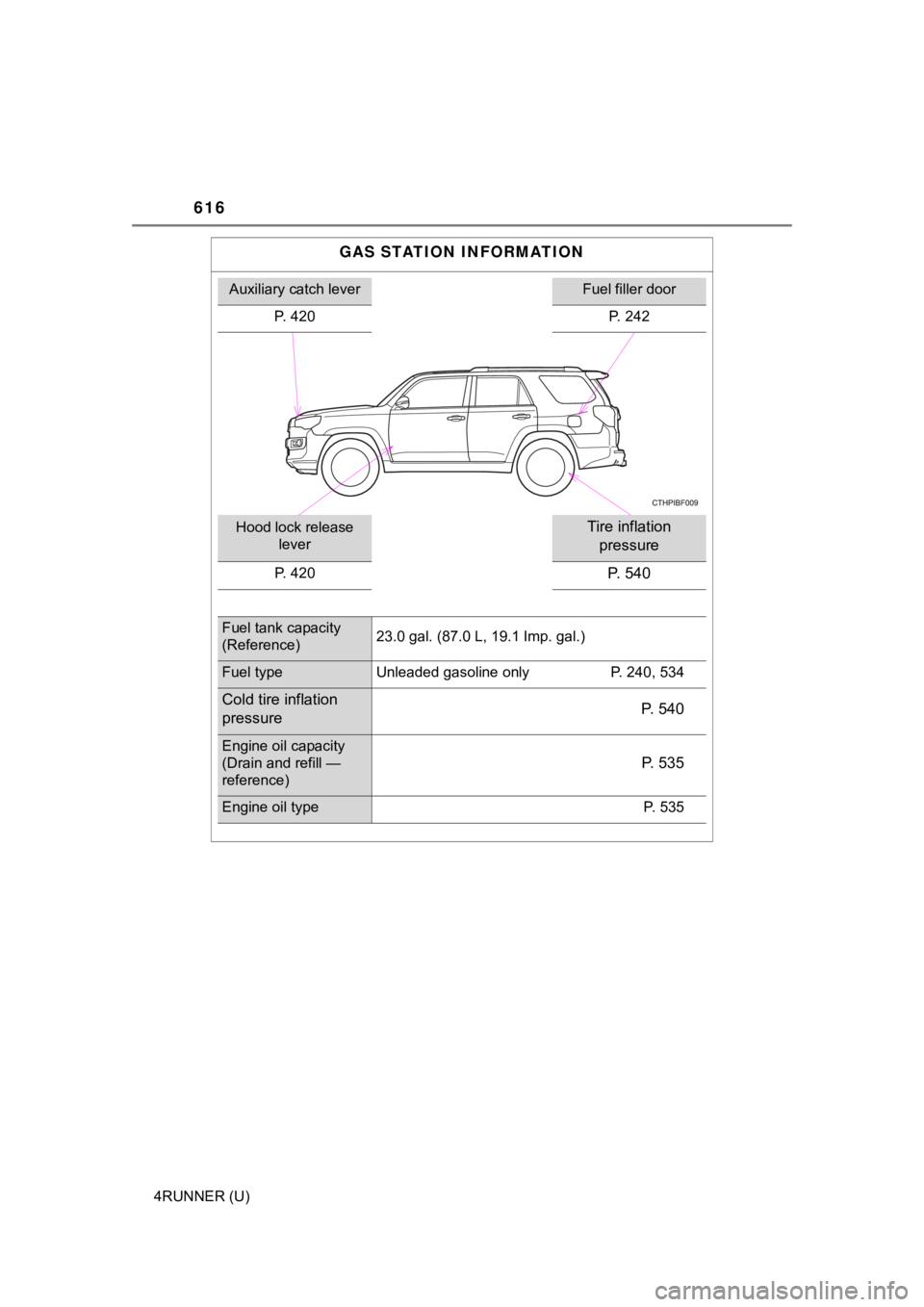2022 TOYOTA 4RUNNER fuel pressure
[x] Cancel search: fuel pressurePage 5 of 616

5
1
8 7
6
5
4
3
2
9
4RUNNER (U)6-1. Maintenance and care
Cleaning and protecting the vehicle exterior .......... 404
Cleaning and protecting the vehicle interior ........... 408
6-2. Maintenance Maintenance requirements ................... 411
General maintenance ........ 413
Emission inspection and maintenance (I/M)
programs ......................... 416
6-3. Do-it-yourself maintenance
Do-it-yourself service precautions ..................... 417
Hood.................................. 420
Engine compartment ......... 421
Tires .................................. 435
Tire inflation pressure........ 448
Wheels .............................. 451
Air conditioning filter .......... 453
Wireless remote control/ electronic key battery ...... 455
Checking and replacing fuses ............................... 459
Light bulbs ......................... 462 7-1. Essential information
Emergency flashers ........... 474
If your vehicle has to be stopped in
an emergency.................. 475
If the vehicle is submerged or water
on the road is rising ......... 477
7-2. Steps to take in an emergency
If your vehicle needs to be towed ...................... 478
If you think something is wrong ........................... 484
Fuel pump shut off system ............................. 485
If a warning light turns on or a warning
buzzer sounds ................. 486
If a warning message is displayed...................... 497
If you have a flat tire .......... 502
If the engine will not start ................................. 517
If you cannot operate back door opener ............ 519
If the electronic key does not operate properly
(vehicles with a
smart key system) ........... 520
If the vehicle battery is discharged ................... 523
If your vehicle overheats......................... 527
If the vehicle becomes stuck ................................ 530
6Maintenance and care7When trouble arises
Page 86 of 616

862. Instrument cluster
4RUNNER (U)
*1: These lights turn on when the engine switch is turned to IGNITION ON
mode (vehicles with a smart key system) or the engine switch is turned to
the “ON” position (vehicles without a smart key system) to indi cate that a
system check is being performed. They will turn off after the engine is
started, or after a few seconds. There may be a malfunction in a system if
the lights do not come on, or do not turn off. Have the vehicle inspected by
your Toyota dealer.
*2: This light flashes to indicate a malfunction.
*3: This light flashes rapidly to indicate a malfunction.
*4: This light flashes continuously to indicate a malfunction.
*5: This light illuminates on the multi-information display.
*6: This light flashes or illuminates to indicate a malfunction.
*1
(if equipped)
BSM OFF (Blind Spot
Monitor) indicator
( P. 491)*5
Low engine oil pressure
warning light ( P. 486)
*1
(Flashes)
(if equipped)
RCTA OFF (Rear Cross
Traffic Alert) indicator
(P. 491)
*1
Power steering warning
light ( P. 488)
*1, 6PCS warning light
(P. 490)*1Master warning light
(P. 497)
*5
(Amber)
LDA indicator ( P. 490)
*1Tire pressure warning
light (P. 490)
Open door warning light
(P. 488)
(if equipped)
Unengaged “Park” warn-
ing light ( P. 488)
Low fuel level warning
light (P. 489)*1
(if equipped)
KDSS warning light
(P. 488)
Seat belt reminder light
(P. 489)*1, 2
(if equipped)
Automatic running
boards indicator light
(P. 488)
Page 364 of 616

3645-1. Using the air conditioning system and defogger
4RUNNER (U)■
Fogging up of the windows
●The windows will easily fog up when the humidity in the vehicle is high.
Turning on will dehumidify the air from the outlets and defog the wind-
shield effectively.
● If you turn off, the windows may fog up more easily.
● The windows may fog up if the recirculated air mode is used.
■ When driving on dusty roads
Close all windows. If dust thrown up by the vehicle is still drawn into the vehi-
cle after closing the windows, it is recommended that the air intake mode be
set to outside air mode and the fan speed to any setting except off.
■ Outside/recirculated air mode
●Setting to the recirculated air mode temporarily is recommended in prevent-
ing dirty air from entering the vehicle interior and helping to cool the vehicle
when the outside air temperature is high.
● Outside/recirculated air mode may automatically switch dependin g on the
temperature setting, outside temperature, pressure, engine cool ant tem-
perature or inside temperature.
■ When the outside temperature exceeds 75°F (24°C) and the air co ndition-
ing system is on
● In order to reduce the air conditioning power consumption, the air condition-
ing system may switch to recirculated air mode automatically. This may also
reduce fuel consumption.
● Recirculated air mode is selected as a default mode when the en gine switch
is turned to the “ON” position (vehicles without a smart key system) or the
engine switch is turned to IGNITION ON mode (vehicles with a sm art key
system).
● It is possible to switch to outside air mode at any time by pre ssing
.
■When the outside tempera ture falls to nearly 32F (0 C)
The dehumidification function may not operate even when is pre ssed.
■ When driving on dusty roads
Close all windows. If dust thrown up by the vehicle is still drawn into the vehi-
cle after closing the windows, it is recommended that the air intake mode be
set to outside air mode and the fan speed to any setting except off.
■ When the indicator light on flashes
Press
to turn off the cooling and dehumidification function and turn it on
again. There may be a problem in the air conditioning system if the indicator
light continues to flash. Turn the air conditioning system off and have it
inspected by your Toyota dealer.
Page 449 of 616

4496-3. Do-it-yourself maintenance
6
Maintenance and care
4RUNNER (U)
Tire valve
Tire pressure gauge
Remove the tire valve cap.
Press the tip of the tire pressure gauge onto the tire valve.
Read the pressure using the gauge gradations.
If the tire inflation pressure is not at the recommended level, adjust
the pressure.
If you add too much air, press the center of the valve to defla te.
After completing the tire inflation pressure measurement and
adjustment, apply soapy water to the valve and check for leakage.
Put the tire valve cap back on.
■Tire inflation pressure check interval
You should check tire inflation p ressure every two weeks, or at least once
a month.
Do not forget to check the spare.
■Effects of incorrect tire inflation pressure
Driving with incorrec t tire inflation pressure may result in th e following:
●Reduced fuel economy
●Reduced driving comfort and poor handling
●Reduced tire life due to wear
●Reduced safety
●Damage to the drive train
If a tire needs frequent inflating , have it checked by your Toyota dealer.
Inspection and adjustment procedure
1
2
1
2
3
4
5
6
Page 495 of 616

4957-2. Steps to take in an emergency
7
When trouble arises
4RUNNER (U)
WARNING
■If the tire pressure warning light comes on
Be sure to observe the following precautions. Failure to do so could
cause a loss of vehicle control and result in death or serious injury.
●Stop your vehicle in a safe place as soon as possible. Adjust the tire
inflation pressure immediately.
●If the tire pressure warning light comes on even after tire inf lation pres-
sure adjustment, it is probable that you have a flat tire. Chec k the tires.
If a tire is flat, change it with the spare tire and have the flat tire
repaired by the nearest Toyota dealer.
●Avoid abrupt maneuvering and braking. If the vehicle tires dete riorate,
you could lose control of the steering wheel or the brakes.
■If a blowout or sudden air leakage should occur
The tire pressure warning system may not activate immediately.
■Maintenance of the tires
Each tire, including the spare (if provided), should be checked monthly
when cold and inflated to the inflation pressure recommended by the
vehicle manufacturer on the vehicle placard or tire inflation p ressure
label (tire and load information label). (If your vehicle has t ires of a dif-
ferent size than the size indicated on the vehicle placard or t ire inflation
pressure label [tire and load information label], you should de termine
the proper tire inflation p ressure for those tires.)
As an added safety feature, your vehicle has been equipped with a tire
pressure monitoring system (TPMS -tire pressure warning system) that
illuminates a low tire pressure telltale (tire pressure warning light) when
one or more of your tires is significantly under-inflated. Acco rdingly,
when the low tire pressure telltale (tire pressure warning ligh t) illumi-
nates, you should stop and check your tires as soon as possible , and
inflate them to the proper pressure. Driving on a significantly under-
inflated tire causes the tire to overheat and can lead to tire failure.
Under-inflation also reduces fuel efficiency and tire tread lif e, and may
affect the vehicle’s handling and stopping ability.
Please note that the TPMS (tire pressure warning system) is not a sub-
stitute for proper tire maintenance, and it is the driver’s res ponsibility to
maintain correct tire pressure, even if under-inflation has not reached
the level to trigger illumination of the TPMS low tire pressure telltale (tire pressure warning light).
Page 551 of 616

5518-1. Specifications
8
Vehicle specifications
4RUNNER (U)
Glossary of tire terminology
Tire related termMeaning
Cold tire inflation pres-
sure
Tire pressure when the vehicle has been
parked for three hours or more, or has not
been driven more than 1 mile or 1.5 km under
that condition
Maximum inflation
pressureThe maximum cold inflated pressure to which
a tire may be inflated, shown on the sidewall
of the tire
Recommended infla-
tion pressureCold tire inflation pressure recommended by a
manufacturer
Accessory weight
The combined weight (in excess of those stan-
dard items which may be replaced) of auto-
matic transmission, power steering, power
brakes, power windows, power seats, radio
and heater, to the extent that these items are
available as factory-installed equipment
(whether installed or not)
Curb weight
The weight of a motor vehicle with standard
equipment, including the maximum capacity of
fuel, oil and coolant, and if so equipped, air
conditioning and additional weight optional
engine
Maximum loaded vehi-
cle weight
The sum of:
(a) Curb weight
(b) Accessory weight
(c) Vehicle capacity weight
(d) Production options weight
Normal occupant
weight150 lb. (68 kg) times the number of occupants
specified in the second column of Table 1
*
that follows
Occupant distributionDistribution of occupants in a vehicle as speci-
fied in the third column of Table 1
* below
Page 603 of 616

603Alphabetical index
4RUNNER (U)
Warning buzzersBrake system ....... ................. 486
Downshifting ......................... 219
Intuitive parking assist .......... 288
Key reminder ................ 208, 492
Lane departure alert function ............................... 261
Open door ............................. 488
Open moon roof reminder..... 492
Pre-collision warning............. 250
Seat belt reminder ................ 489
Warning lights............................ 85 ABS....................................... 487
Automatic running boards
indicator light ...................... 488
Brake override system .......... 489
Brake system ....... ................. 486
Center differential lock indicator light ...................... 488
Charging system ................... 486
Drive-Start Control ................ 489
Four-wheel drive indicator light ...................... 488
KDSS .................................... 488
LDA indicator ........................ 490
Low engine oil pressure ........ 486
Low fuel level ........................ 489
Low speed four-wheel drive indicator light ...................... 488
Malfunction indicator lamp .... 487
Master warning light...... 490, 497
Multi-terrain Select indicator light ...................... 488
Open door ............................. 488
PCS ...................................... 490
Power steering ...................... 488
Rear differential lock indicator light ...................... 487
Seat belt reminder light ......... 489 Slip indicator ......................... 487
SRS ...................................... 487
Tire pressure ........................ 490
Unengaged “Park” ................ 488
Warning messages.................. 497
Washer ..................................... 234
Checking............................... 433
Preparing and checking before winter ...................... 342
Switch ........................... 234, 237
Washing and waxing ............... 404
Weight
Cargo capacity...................... 189
Load limits ............................ 189
Weight .................................. 532
Wheels ...................................... 451 Replacing wheels ................. 451
Size....................................... 540
Window glasses ...................... 161
Window lock switch ................ 161
Windows................................... 161 Power back window .............. 165
Power windows..................... 161
Rear window defogger ..................... 354, 361
Washer ......................... 234, 237
Windshield wiper
de-icer ............................ 354, 362
Windshield wipers ........... 234, 237 Intermittent wiper .................. 234
Winter driving tips ................... 342
Wireless remote control key .......................................... 105
Locking/Unlocking ................ 110
Replacing the battery............ 455
W
*: Refer to the “NAVIGATION AND MULTIMEDIA SYSTEM OWNER’S MANUAL”.
Page 616 of 616

616
4RUNNER (U)
GAS STATION INFORMATION
Auxiliary catch leverFuel filler door
P. 420 P. 242
Hood lock release
leverTire inflation
pressure
P. 420P. 540
Fuel tank capacity
(Reference) 23.0 gal. (87.0 L, 19.1 Imp. gal.)
Fuel type
Unleaded gasoline only P. 240, 534
Cold tire inflation
pressure P. 5 4 0
Engine oil capacity
(Drain and refill —
reference)
P. 5 3 5
Engine oil type
P. 535